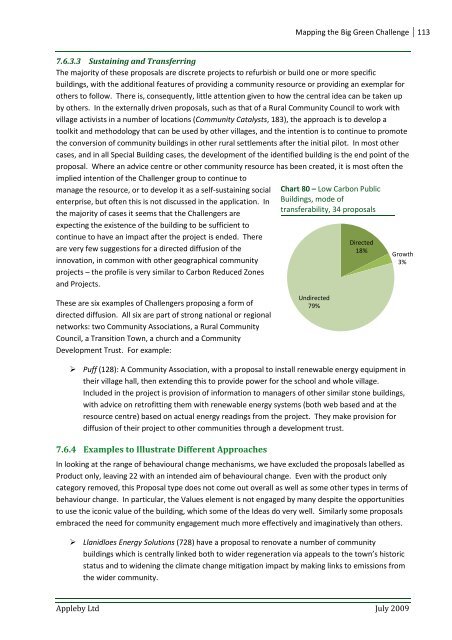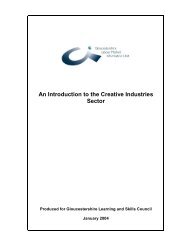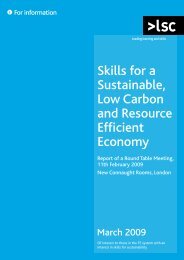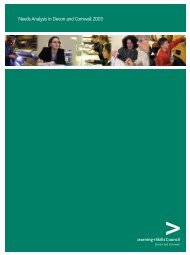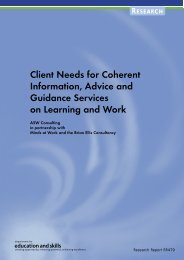Mapping the Big Green Challenge - The Skills & Learning ...
Mapping the Big Green Challenge - The Skills & Learning ...
Mapping the Big Green Challenge - The Skills & Learning ...
You also want an ePaper? Increase the reach of your titles
YUMPU automatically turns print PDFs into web optimized ePapers that Google loves.
<strong>Mapping</strong> <strong>the</strong> <strong>Big</strong> <strong>Green</strong> <strong>Challenge</strong> 1137.6.3.3 Sustaining and Transferring<strong>The</strong> majority of <strong>the</strong>se proposals are discrete projects to refurbish or build one or more specificbuildings, with <strong>the</strong> additional features of providing a community resource or providing an exemplar foro<strong>the</strong>rs to follow. <strong>The</strong>re is, consequently, little attention given to how <strong>the</strong> central idea can be taken upby o<strong>the</strong>rs. In <strong>the</strong> externally driven proposals, such as that of a Rural Community Council to work withvillage activists in a number of locations (Community Catalysts, 183), <strong>the</strong> approach is to develop atoolkit and methodology that can be used by o<strong>the</strong>r villages, and <strong>the</strong> intention is to continue to promote<strong>the</strong> conversion of community buildings in o<strong>the</strong>r rural settlements after <strong>the</strong> initial pilot. In most o<strong>the</strong>rcases, and in all Special Building cases, <strong>the</strong> development of <strong>the</strong> identified building is <strong>the</strong> end point of <strong>the</strong>proposal. Where an advice centre or o<strong>the</strong>r community resource has been created, it is most often <strong>the</strong>implied intention of <strong>the</strong> <strong>Challenge</strong>r group to continue tomanage <strong>the</strong> resource, or to develop it as a self-sustaining socialenterprise, but often this is not discussed in <strong>the</strong> application. In<strong>the</strong> majority of cases it seems that <strong>the</strong> <strong>Challenge</strong>rs areexpecting <strong>the</strong> existence of <strong>the</strong> building to be sufficient tocontinue to have an impact after <strong>the</strong> project is ended. <strong>The</strong>reare very few suggestions for a directed diffusion of <strong>the</strong>innovation, in common with o<strong>the</strong>r geographical communityprojects – <strong>the</strong> profile is very similar to Carbon Reduced Zonesand Projects.Chart 80 – Low Carbon PublicBuildings, mode oftransferability, 34 proposalsDirected18%Growth3%<strong>The</strong>se are six examples of <strong>Challenge</strong>rs proposing a form ofdirected diffusion. All six are part of strong national or regionalnetworks: two Community Associations, a Rural CommunityCouncil, a Transition Town, a church and a CommunityDevelopment Trust. For example:Undirected79% Puff (128): A Community Association, with a proposal to install renewable energy equipment in<strong>the</strong>ir village hall, <strong>the</strong>n extending this to provide power for <strong>the</strong> school and whole village.Included in <strong>the</strong> project is provision of information to managers of o<strong>the</strong>r similar stone buildings,with advice on retrofitting <strong>the</strong>m with renewable energy systems (both web based and at <strong>the</strong>resource centre) based on actual energy readings from <strong>the</strong> project. <strong>The</strong>y make provision fordiffusion of <strong>the</strong>ir project to o<strong>the</strong>r communities through a development trust.7.6.4 Examples to Illustrate Different ApproachesIn looking at <strong>the</strong> range of behavioural change mechanisms, we have excluded <strong>the</strong> proposals labelled asProduct only, leaving 22 with an intended aim of behavioural change. Even with <strong>the</strong> product onlycategory removed, this Proposal type does not come out overall as well as some o<strong>the</strong>r types in terms ofbehaviour change. In particular, <strong>the</strong> Values element is not engaged by many despite <strong>the</strong> opportunitiesto use <strong>the</strong> iconic value of <strong>the</strong> building, which some of <strong>the</strong> Ideas do very well. Similarly some proposalsembraced <strong>the</strong> need for community engagement much more effectively and imaginatively than o<strong>the</strong>rs. Llanidloes Energy Solutions (728) have a proposal to renovate a number of communitybuildings which is centrally linked both to wider regeneration via appeals to <strong>the</strong> town’s historicstatus and to widening <strong>the</strong> climate change mitigation impact by making links to emissions from<strong>the</strong> wider community.Appleby Ltd July 2009


